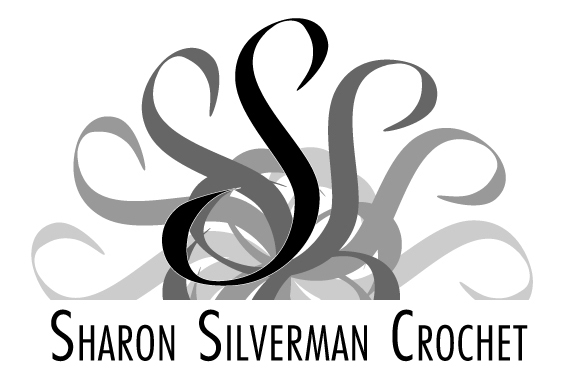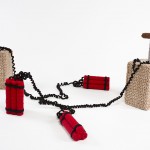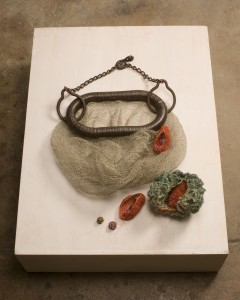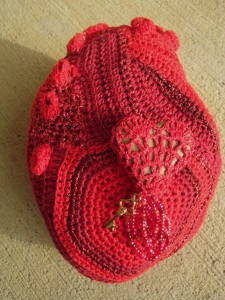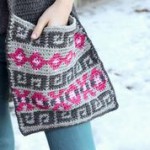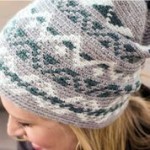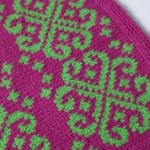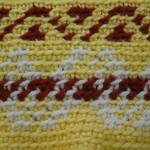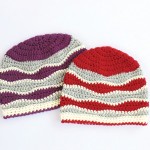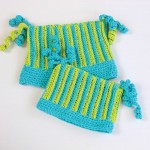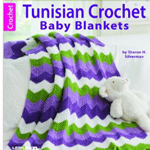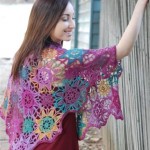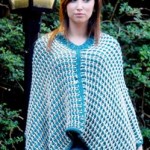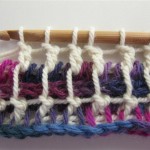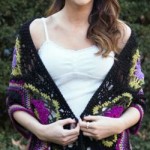Most crochet books in my collection are pattern books or stitch guides. Today I'm reviewing a different kind of volume, more museum exhibition catalog than how-to. It's The Fine Art of Crochet: Innovative Works from 20 Contemporary Artists by Gwen Blakley Kinsler. (I received a review copy from AuthorHouse™; as always in my reviews, what follows is an honest assessment. Photos are used with permission.)
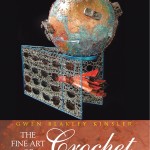
I knew I would like this book as soon as I saw that the introductory quote is from Bruce Hoffman, Director of the Snyderman-Works Gallery in Philadelphia. "Crocheting, like felting, knitting and weaving, is finding a new wonderful voice in contemporary art making, impressively breaking previous stereotyped borders," he says. (Hoffman knows what he's talking about. The gallery is hosting the 9th International Fiber Biennial right now, through April 26, 2014. I have to get down there before it closes!) Click here for the gallery.
Gwen Kinsler's crochet credentials are impeccable. The "Crochetqueen" is founder of the Crochet Guild of America. Just think about what that means. Those of us who are members may take the Guild's existence and services for granted, but without Gwen, it wouldn't exist. CGOA has been instrumental in elevating crochet to its deserved position in the world of fiber arts. That alone would guarantee Gwen a solid place in crochet history, as would her design work, but she's not one to rest on her laurels. Her passion for contemporary art and the intrinsic worth of crochet led her to dream of curating a book showcasing what we can call "art crochet." The Fine Art of Crochet realizes that ambition.
What can you expect to find in this inspiring, lavishly illustrated book? First is some excellent introductory material about the origins of crochet and its modern evolution/revolution. The heart of the book features twenty artists, some of whom have been practicing their art and craft for decades, others who have picked up the hook more recently. There is a biography of each artist, nice big photos of some of their works, and quotes in which they explain what motivates them and what their goals are.
Contemporary art can be beautiful, inspiring, unsettling, or all three, the perfect vehicle for stimulating dialogue. The items in this book are no exception. Reading what the artist intended is often educational in this regard. For example, the throw-rug sized circles in Carol Hummel's "Aspen Invasion," an installation in Steamboat Springs, CO, struck me as a fun and colorful path from one hot tub to the next. I could picture vacationers sprinting between properties on a snowy day. It was a bit shocking to learn that the artist was making a statement about environmental protection in the face of development, and that what I had perceived as stepping-stones actually represented viruses oozing out of the hot water and smothering everything in their way.
Nathan Vincent's crochet sculpture, "Dynamite," envelops rough, harsh objects in soft, inviting fiber. This artistic exploration of gender stereotypes blurs the line between masculine and feminine.
In Leslie Pontz's "Cactus Arm Flowered #5," the artist uses crocheted wire, thread, iron, and paint to represent a deflated cactus form that gives rise to the seeds of the next generation. "My work is `edgy' and is a visual presentation that requires people to think outside the box," says the artist.
For Gwen Kinsler, keeping a sense of humor is essential. Her playful approach, creativity, and crochet skills led her to create "Heartrock Hotel," made of Kreinik™ metallic thread. She has covered rocks in crochet for years, and explains the motivation for this piece:
I have a degree in nursing and when I worked in an adult day center with clients with dementia, my boss gave me a small rock shaped like a heart. I had also collected the larger rock that I noticed was truly shaped like an anatomical heart. One day in the shower it came to me (it's where most of my good ideas surface!): "Heartrock," a play on the Hard Rock chain of hotels. So, I challenged myself to crochet over the rock and to place the large vessels in their correct locations. The vessels became the hotel rooms and I called the larger "pulmonary artery" the penthouse. That's where I attached the smaller covered heart with a small chain to keep it in place, but moveable."
Throughout the book you can expect to see familiar and non-traditional materials; figurative and abstract works; mathematically conceived and nature-inspired pieces; items that fit in your hand or take up a gallery wall; pieces to be worn, pieces to be displayed, pieces to gape at. Here is a complete list of artists Gwen Blakley Kinsler has included:
Arlene Frisch; Georgina Valverde; Pate Conaway; Carol Hummel; Renie Breskin Adams; Donna Lish; Dale Roberts; Nathan Vincent; Andrea Uravitch; Kathleen Holmes; Tracy Krumm; Donna Rosenthal; Karen Searle; Soonran Youn; Jerry Bleem; Jo Hamilton; Yvette Kaiser Smith; Bonnie Meltzer; Carol Ventura.
(I was delighted to see Dr. Ventura's tapestry crochet included. From her practical yet beautiful "Geometry Tote" to her crocheted portraits, Carol's name is synonymous with tapestry crochet. She is also a generous teacher: I took her course through CGOA several years ago and remain grateful for her encouragement.)
There are a few technical issues with the book. Some of the photo captions look like they were imperfectly cut-and-pasted—the bottom parts of letters are cut off. Also, it is sometimes hard to tell the captions from the text. It would have been nice to have the artist's name with every picture, as well as the date that the pictured item was created. There are other little glitches (like the missing comma or colon to set off a quote on p. 13, and the backwards quotation marks there). Although AuthorHouse provides editing, it would have been a good idea for Gwen Kinsler to send a pre-press copy to another proofreader.
Don't let these minor problems discourage you from exploring this worthwhile book. The Fine Art of Crochet is a much-needed exploration of the diverse styles, shapes, and textures of today's crochet. Marvel at the creations within, and be inspired.
The Fine Art of Crochet by Gwen Blakley Kinsler. Published by AuthorHouse. 112 pages; ISBN-10: 1481731866; ISBN-13: 978-1481731867. List price $34.99
Purchase from Amazon here.
